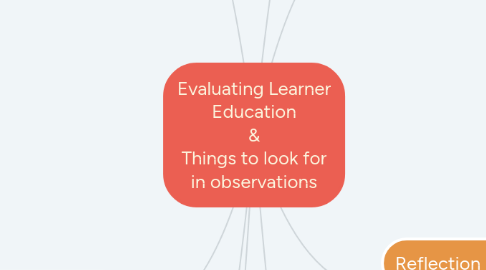
1. Kagan Structure - shows 4 principles - cooperative learning
1.1. P.I.E.S.
1.1.1. P: Positive interdependence
1.1.1.1. - The success of one also benefits others - Positive correlation among outcomes
1.1.1.1.1. Ex: - Team game where all scores matter, so everyone works together (all contribution is necessary) - Students help other students who may want to give up
1.1.2. I: Individual accountability
1.1.2.1. 3 Components: 1) individual 2) public 3) required
1.1.2.2. - If we leave out any of these, active engagement is less likely - Students who may not want to participate have to be a part of what is happening
1.1.2.2.1. Ex: - Numbered heads together: everyone writes answers down, compares and teacher calls a number (which multiple students may have)
1.1.3. E: Equal participation
1.1.3.1. - Equal participation leads to more active engagement - Try to include those that are shy and/or avoiding working - With a typical group project, there are the quiet ones and those who do nothing; try to avoid that
1.1.3.1.1. Ex: - Team interview: each student is interviewed for a minute by classmates about the issue
1.1.4. S: Simultaneous Interaction
1.1.4.1. - Focuses on the absolute amount of engagement instead of the equality - Used to evaluate cooperative learning
1.1.4.1.1. Ex: - RallyRead: Groups/pairs of students read aloud together instead of one student reading to the class. This is so the teacher can focus on multiple students. The student has more engagement with the task this way.
2. Learning Retention
2.1. Average Learning Retention Rates: - Lecture 5% - Reading 10% - Audio visual 20% - Demonstration 30% - Practice by doing 75% - Teaching others 90%
2.1.1. - Classify the types of activities going on in the classroom - Look at the chart to see how engaged they may be with what they do - Will the students retain what they learn?
3. Demonstrating Agency
3.1. Agency: amount of self-direction and control students have (the more, the better) 1) choice 2) creativity 3) leading 4) teaching 5) facilitating learning
3.1.1. Ex: PET scans show that explaining to a partner has widespread brain activity, compared to simpler tasks like reading and decoding/encoding words - Traditional methods may not be the best for agency since there is a lack of the student engaging; strive for more agency
3.1.1.1. - When observing, think about whether the activities have agency, making learning more effective - Is the agency working for the activity the teacher is doing?
4. Teacher and Student Directed
4.1. For retention, a mix of teacher and student directed activities is recommended, since lectures have about 5% retention
4.1.1. The amount of teacher and student direction depends on the instructor
4.1.1.1. - Does the mix of teacher and student direction seem effective? - Did the students seem more engaged in directing?
4.2. Concerning agency, peers helping each other shows more brain activity than traditional activities
5. Social/Emotional Needs
5.1. Implicitly
5.1.1. Implicit needs: - motivates behavior - unconscious - triggered by emotion - (confidence, success...)
5.1.1.1. How they're addressed and met: - observe the students to see if there is a need that seems unmet - help student achieve needs by giving support and/or praise
5.1.1.1.1. - Look for these needs and observe if the teacher notices/does anything about them
5.2. Explicitly
5.2.1. Explicit needs: - directly stated - conscious
6. Reflection (Metacognition)
6.1. Metacognition: - awareness of own thought process - actively thinking about thinking - students learn to monitor their comprehension
6.1.1. Four Dimensions with examples: 1) Social - sharing reading processes, problems and solutions - investigating relationships 2) Personal - developing reader identity, fluency, stamina, etc. - developing metacognition 3) Cognitive - getting the big picture - breaking it down 4) Knowledge-building - surfacing,building and refining schema - building knowledge of content, texts, language, etc.
6.1.1.1. Ex: Metacognition sentence stems helps interact by thinking about learning because it involves what matters to the students. "At this point...: - I'm thinking..." - I'm noticing..." - I'm wondering..." - I'm seeing..." - I'm feeling..." - etc.
6.1.1.1.1. - Look to see if the students reflect on the activity with their thoughts - Are they simply saying facts, or reflecting to understand?
7. Synthesizing
7.1. Synthesizing: high-level thinking where parts of information are looked at as a whole to find new meaning - pulling together background knowledge and knowledge of the text - often difficult
7.1.1. This can be done by evaluating and reflecting instead of just retelling the story
7.1.1.1. Ex: - Students can compare synthesizing to ripples and make a chart labeled like this: 1) At first, I was thinking... 2) Now, I'm thinking... 3) After reading, I think...
7.1.1.1.1. - Look for examples of synthesizing, where the teacher is trying to get the student to expand their thinking and knowledge - Are the methods the teacher use successful?
